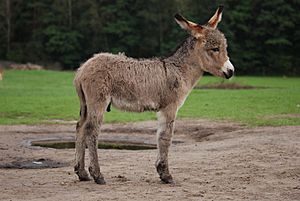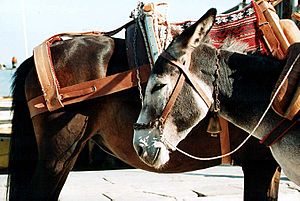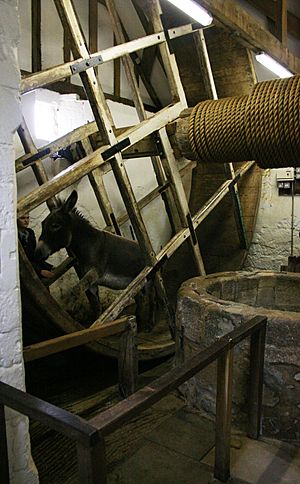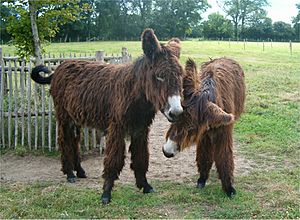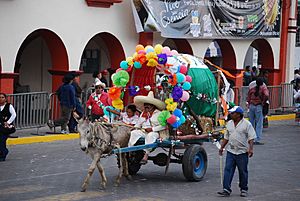Donkey facts for kids
Quick facts for kids Donkey |
|
|---|---|
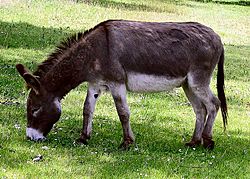 |
|
| Scientific classification | |
| Kingdom: | |
| Phylum: | |
| Class: | |
| Order: | |
| Family: | |
| Genus: | |
| Binomial name | |
| Equus africanus |
|
| Trinomial name | |
| Equus africanus asinus |
|
A donkey or ass (Equus africanus asinus) is a mammal that belongs to the Equidae family, which also includes horses and zebras. Donkeys are related to the African wild ass, which is their wild ancestor. People have used donkeys as working animals for at least 5,000 years.
The word 'donkey' usually refers to the tame animal. People use donkeys for transportation, carrying things, or helping with farm work like plowing fields.
Donkeys can also have babies with horses! When a female horse and a male donkey have a baby, it's called a mule. If a female donkey and a male horse have a baby, it's called a hinny. Mules are more common and are often used for carrying people and goods.
Contents
About Donkeys

Donkeys come in many different sizes. Their height can range from about 70 cm to 155 cm at the shoulder. They can weigh from 80 kg to 480 kg. Donkeys that work in poorer countries might live for 12 to 15 years. But in richer countries, they can live much longer, sometimes up to 30 to 50 years!
Donkeys are very good at living in dry, desert-like places. Unlike wild horses, donkeys in dry areas often live alone. They don't form large groups. Each adult donkey has its own home area. Donkeys have a very loud call, called a bray. It can last for about 20 seconds and be heard over three kilometers away! This helps them stay in touch with other donkeys in wide-open spaces. Donkeys also have big ears, which help them hear sounds from far away. Their ears might also help cool their blood. Donkeys can protect themselves by biting, kicking with their front hooves, or kicking with their back legs.
Donkey Reproduction
A female donkey, called a jenny, is usually pregnant for about 12 months. Sometimes it can be a bit shorter or longer, from 11 to 14 months. Jennies usually give birth to just one baby, called a foal. Having twins is very rare for donkeys.
Jennies are very protective of their foals. This means they might not be ready to have another baby until their current foal is older. Because of how long they are pregnant, a jenny will usually have fewer than one foal per year. Donkey breeders often plan for three foals in four years, rather than one every year like horse breeders might.
Donkeys can also breed with other animals in the Equidae family. They often breed with horses. The baby of a male donkey and a female horse is a mule. Mules are very useful for work and riding in many countries. Some large donkey breeds are raised just to produce mules. The baby of a male horse and a female donkey is a hinny. Hinnies are less common. Like other mixed-species babies, mules and hinnies usually cannot have their own babies. Donkeys can also breed with zebras! Their babies are called zonkeys (or other names).
Donkey Behavior
Donkeys sometimes have a reputation for being stubborn. But this is actually because they have a very strong sense of self-preservation. It's harder to make a donkey do something it thinks is dangerous. Once a person earns a donkey's trust, they can be very friendly and reliable partners.
Donkeys are quite smart, careful, friendly, and playful. They are also eager to learn new things.
Donkey History

The donkeys we know today came from the Nubian and Somalian types of African wild ass. People found bones of tame donkeys in Egypt that are about 6,000 years old. Donkeys were probably first tamed by people in Nubia. They became very important for carrying goods, even more so than oxen. Donkeys helped people travel and trade over long distances in Egypt.
In ancient Egypt, rich people sometimes owned over 1,000 donkeys. They used them for farming, for milk and meat, and for carrying things. In 2003, archaeologists found the skeletons of ten donkeys buried near an early Egyptian pharaoh. This shows how important donkeys were to the early Egyptian rulers.
By the end of the fourth millennium BC, donkeys had spread to Southwest Asia. By 1800 BC, Mesopotamia became a main place for breeding donkeys. People in Damascus were known for breeding large, white donkeys for riding. The Muscat or Yemen ass was developed in Arabia. Donkeys arrived in Europe around 2000 BC. The Greeks and Romans then spread them throughout their empires.
The first donkeys came to the Americas with Christopher Columbus in 1495. They were landed in Hispaniola. Later, donkeys came to North America and were used in missions and mines. During the Gold Rush in the 1800s, donkeys (often called burros) were the main animals used by gold prospectors in the western United States. When the gold rush ended, many donkeys escaped or were left behind. They formed wild populations.
How Donkeys Are Used
Working Donkeys

Donkeys have been working animals for at least 5,000 years. Most of the world's 40 million donkeys live in developing countries. There, they are mainly used to carry things or pull carts for transport or farming. After human labor, donkeys are the cheapest way to power farm work. They can also be ridden, or used for tasks like threshing grain, pulling water from wells, or grinding food. Working donkeys are often found with people who live in very poor conditions.
In China, donkey meat is sometimes eaten. Also, Donkey-hide gelatin is made from donkey hide. It is used in traditional Chinese medicine.
Donkeys in Warfare
During World War I, two soldiers, John Simpson Kirkpatrick and Richard Alexander "Dick" Henderson, used donkeys to help rescue injured soldiers from the battlefield at Gallipoli.
Donkeys have also been used to carry supplies and sometimes explosives in wars, including the war in Afghanistan.
Donkey Care
Shoeing Donkeys
Donkey hooves are more flexible than horse hooves. They don't wear down as quickly on their own. So, donkeys often need their hooves trimmed regularly. If their hooves are not cared for, it can cause lasting damage. Working donkeys might need special shoes, similar to horseshoes, but usually smaller.
Donkey Nutrition
In their natural dry homes, donkeys spend more than half their day looking for and eating food. They often eat poor quality plants. Donkeys have a strong digestive system that can break down tough plant material very well. They need less food than a horse of the same size. Donkeys are also less likely to get colic, a painful stomach problem.
Donkeys get most of their energy from plant fibers. Some people say donkeys only need to eat straw (like barley straw) and some grass or hay to get all their energy and nutrients. Others suggest giving them some grain, especially if they are working hard. Donkeys do best when they eat small amounts of food over a long time.
If donkeys live in places with lots of rich grass, they can easily become overweight. This can lead to health problems like laminitis, which affects their hooves. Many working donkeys around the world are underfed and overworked. But in cooler climates, the food available is often too rich. Overfeeding can cause donkeys to gain too much weight and develop health issues.
Burro
In Spain and the Americas, a burro is a small donkey. The word "burro" is Spanish and Portuguese for donkey. In the United States, "burro" is used to describe any small donkey used mainly for carrying things. It also refers to the wild donkeys that live in states like Arizona, California, and Nevada.
Burros are usually on the smaller side compared to other donkeys. In Mexico, working burros typically weigh between 50 kg and 186 kg. They are often gray in color. Mexican burros tend to be smaller than burros found in the USA.
Wild Donkeys and Asses
Some domestic donkeys have gone back to living in the wild. These are called feral populations. Examples include the Burro in North America and the Asinara donkey in Italy. These wild populations are sometimes protected. However, feral donkeys can also cause problems, especially in places where there were no horses or donkeys before, like Hawaii. In Australia, there are millions of feral donkeys. They are seen as a pest because they can harm the environment. They might compete with other animals for food, spread weeds and diseases, and damage water sources.
Different Types of Wild Asses
There are only a few types of wild asses left in the world. The African wild ass has two main types: the Somali wild ass and the Nubian wild ass. The Nubian wild ass is the main ancestor of our domestic donkeys. Both of these are now critically endangered, meaning they are at high risk of disappearing forever.
There are also five types of Asiatic wild ass, called onagers, and three types of kiangs, which live in the Himalayan mountains.
Donkey Hybrids
When a male donkey (jack) breeds with a female horse, they create a mule. When a male horse breeds with a female donkey, they create a hinny.
Horse-donkey hybrids like mules and hinnies are almost always unable to have their own babies. This is because horses have 64 chromosomes, while donkeys have 62. Their offspring end up with 63 chromosomes, which makes them sterile. Mules are much more common than hinnies. This is partly because male donkeys are often more willing to breed with female horses than male horses are with female donkeys. Also, female horses are usually bigger than female donkeys, so they have more room for the baby to grow inside them. Mules are generally believed to be easier to handle and physically stronger than hinnies, which makes them more popular for breeding.
The baby of a zebra and a donkey is called a zonkey, zebroid, or zedonk. These names usually refer to babies born from a male zebra and a female donkey. If a female zebra breeds with a male donkey, the baby is called a zebra hinny or zebrinny. Zebrinnies are rarer because female zebras are more valuable for breeding purebred zebras.
Images for kids
-
Lt. Richard Alexander "Dick" Henderson using a donkey to carry a wounded soldier at the Battle of Gallipoli
See also
 In Spanish: Burro para niños
In Spanish: Burro para niños


